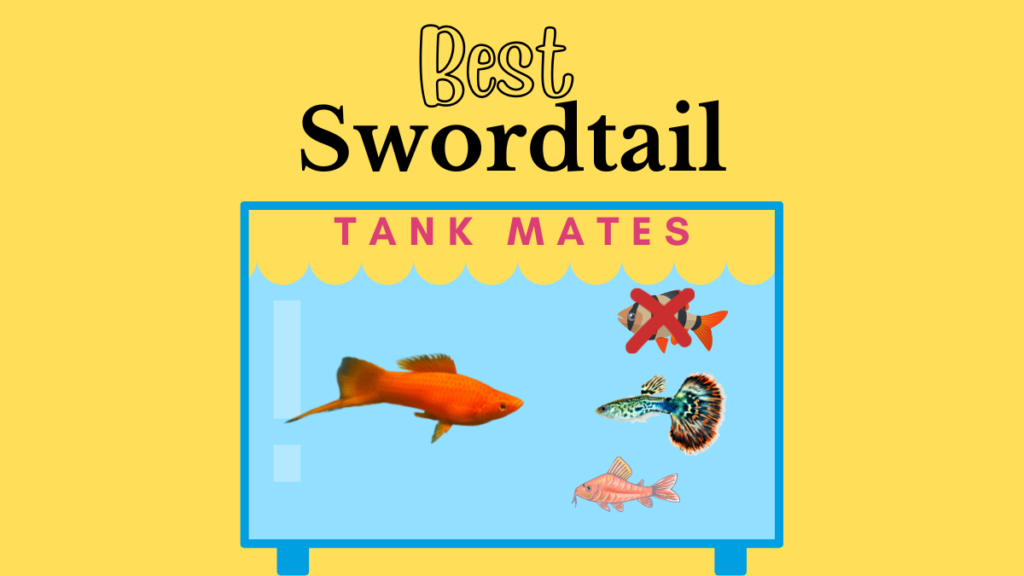Are you looking for tank mates for swordtails? Swordtails (Xiphophorus helleri) are a popular livebearer freshwater fish. They are widely distributed and are available in most pet stores.
Male Swordtails are characterized by their sword-like tails, while female Swordtails are rounder. There are many color variations of swordtails, but the most popular are the orange colored swordtails.
Swordtails are great fish for beginners because they are easy to keep. So what fish will get along with swordtails? Here are the best tank mates for swordtails.
3 Factors to Consider When Selecting Swordtail Tank Mates
When selecting tank mates for swordtails, there are 3 factors to consider to make sure your swordtails and tank mates are happy.
1. Water Parameters Should be Similar to Swordtails
Choose tank mates that have similar water parameters as Swordtails. Swordtails prefer medium, hard water that is slightly alkaline. Avoid fish that will need soft, acidic water.
2. Avoid Fin Nippers with Swordtails
Although Swordtails don’t have the big showy fins of some fish. Nevertheless, you should avoid aggressive fin nippers as tank mates for Swordtails. You don’t want fin nippers to nip the long sword-like tails of Swordtails! Definitely don’t mix Tiger Barbs with Swordtails.
3. Will You Be Breeding Swordtails?
Are you planning to breed Swordtails? If so, that will affect the tank mates you choose for your Swordtail. Most fish will eat smaller fish that can fit in their mouths. Even the most peaceful fish are guilty of eating smaller fish. It’s their natural instinct!
Definitely keep that in mind when choosing tank mates for swordtails. Avoid big fish, stick with small fish with small mouths as tank mates for swordtails.
9 Fish that are Compatible with Swordtails
1. Guppy (Poecilia reticulata)
Characteristics
| Name | Guppy |
| Scientific Name | Poecilia reticulata |
| Origin | Central America Mexico, Guatemala, Honduras |
| Size | 2 inches (5 cm) |
| Temperament | Peaceful |
| Ease of Care | Easy |
| Water Parameters | Medium Hard Water. Alkaline, pH 7.5 |
| Water Temperature | 70-77F (21-25C) |
| Water Column | Midwater Fish |
Guppies will get along well with your swordtails. They are peaceful and lively fish and will live peacefully with your swordtails. Keep Guppies in groups of 4 to 6. The male guppies are characterized by their colorful tails, while the females are larger and more drab looking. Guppies are active and peaceful fish that are a lot of fun for beginners. They are also very hardy and can tolerate a wide range of water conditions. Similar to other swordtails, Guppies breed easily.
2. Platy (Xiphophorus maculatus)
Characteristics
| Name | Platy |
| Scientific Name | Xiphophorus maculatus |
| Origin | Central America Mexico, Guatemala, Honduras |
| Size | 2.5 inches (6 cm) |
| Temperament | Peaceful |
| Ease of Care | Easy |
| Water Parameters | Medium Hard to Alkaline, pH 7.5 |
| Water Temperature | 64-77F (18-25C) |
| Water Column | Midwater Fish |
Platies are ideal tank mates for swordtails. They are peaceful and are compatible with swordtails. Platies are also hardy, so it’s great for beginners. Platies come in many color varieties, from albino to vibrant orange. Similar to swordtails, platies are livebearers and breed easily.
3. Black Molly (Poecilia sphenops)
Characteristics
| Name | Black Molly |
| Scientific Name | Poecilia sphenops |
| Origin | Central America Mexico, Guatemala, Honduras |
| Size | 3.5 inches (8.5 cm) |
| Temperament | Peaceful |
| Ease of Care | Easy |
| Water Parameters | Brackish Water. Hard Water. Alkaline, pH 7.5 |
| Water Temperature | 75-81F (24-27C) |
| Water Column | Midwater Fish |
Black Mollies are compatible fish with swordtails. They are peaceful fish and will get along nicely with swordtails. Keep Black Mollies in groups of 4 to 6. One thing to note, Black Mollies are not as hardy as swordtails though. They are susceptible to diseases if the water is not slightly brackish or hard. Similar to swordtails, Black Mollies will breed easily.
4. Endler (Poecilia reticulata)
Characteristics
| Name | Endler |
| Scientific Name | Poecilia reticulata |
| Origin | Central America Mexico, Guatemala, Honduras |
| Size | 2 inches (5 cm) |
| Temperament | Peaceful |
| Ease of Care | Easy |
| Water Parameters | Medium Hard Water. Alkaline, pH 7.5 |
| Water Temperature | 70-77F (21-25C) |
| Water Column | Midwater Fish |
Endlers will get along nicely in the same aquarium as swordtails. They are livebearers that look very similar to guppies because they are the wild form of guppies. Endlers are very colorful fish, more colorful than guppies! Endlers are prolific breeders. Don’t mix guppies and Endlers in the same tank since they will interbreed and you will lose the beautiful Endler colors.
5. Bronze Corydoras (Corydoras aeneus)
Characteristics
| Name | Bronze Corydoras |
| Scientific Name | Corydoras aeneus |
| Origin | South America |
| Size | 2.75 inches (7cm) |
| Temperament | Peaceful |
| Ease of Care | Moderate |
| Water Parameters | Soft, pH 6-7 |
| Water Temperature | 64-79F(18-26C). |
| Water Column | Bottom Dweller Fish |
Bronze Corydoras are bottom dwelling fish that will get along nicely with swordtails. They are peaceful community fish. Corydoras are also hardy fish and can tolerate a wide range of water parameters which makes them easy, adaptable fish.
Corydoras are social and should be kept with other Corydoras of the same species. If you have space in your aquarium, keep at least 5 Corydoras in a group.
Even though they are scavengers, you still need to feed Cory catfish their own food. It’s not enough to rely on food collected from scavenging as their only food source. You should supplement their diet with sinking pellets that are formulated for bottom-dwelling fish.
6. Otocinclus (Otocinclus affinis)
Characteristics
| Name | Otocinclus |
| Scientific Name | Otocinclus affinis |
| Origin | South America |
| Size | 1.5 inches (4 cm) |
| Temperament | Peaceful |
| Ease of Care | Moderate |
| Water Parameters | Soft and Slightly Acidic, pH 6.5-7.0 |
| Water Temperature | 72-77F (22-25C) |
| Water Column | Bottom Dweller |
Otocinclus are peaceful fish that will not bother swordtails. They are algae eaters and are a great addition to community tanks. Get a group of Otos so they have company.
Otocinclus is a popular choice for fishkeepers looking for an algae eater to clean their tank. Otos are peaceful fish. They are sensitive to nitrate levels, so it’s important to keep the water quality in good condition with regular water changes.
7. Bristlenose Catfish (Ancistrus temminckii)
Characteristics
| Name | Bristlenose Catfish |
| Scientific Name | Ancistrus temminckii |
| Origin | South America |
| Size | 6 inches (15cm) |
| Temperament | Territorial |
| Ease of Care | Moderate |
| Water Parameters | Soft to Acidic, pH 6-7 |
| Water Temperature | 75-82F (24-28C) |
| Water Column | Bottom Dweller Fish |
Bristlenose Catfish is a good tank mate for swordtails. It’s a bottom dweller, algae eater that will get out of the way of swordtails. Bristlenose Catfish can get territorial with other Bristlenose Catfish and other bottom dwellers, so it’s best to keep just one or a pair of Bristlenose Catfish (one male and one female).
Bristlenose Catfish are good algae eaters and will do a good job cleaning your tank. Make sure you supplement their feeding with sinking pellets because they will feed on aquarium plants if there is not enough algae in the aquarium.
8. Boeseman’s Rainbowfish (Melanotaenia boesemani)
Characteristics
| Name | Boeseman’s Rainbowfish |
| Scientific Name | Melanotaenia boesemani |
| Origin | New Guinea |
| Size | 4.75 inches (12 cm) |
| Temperament | Peaceful |
| Ease of Care | Moderate |
| Water Parameters | Neutral to hard, pH 7-8 |
| Water Temperature | 75-82F (24-28C) |
| Water Column | Midwater Fish |
Boeseman’s Rainbowfish are good tank mates with swordtails. They are beautiful, active schooling fish. Keep 4-6 in a tank and you will have a thriving community of Boeseman’s Rainbowfish.
Boeseman’s Rainbowfish characterized by the yellow/orange and blue colors. They are active fish that will thrive in an aquarium with plants and a spacious open swim area. A well-filtered tank that does not have a strong current is ideal.
9. Coolie Loach (Pangio kuhlii)
Characteristics
| Name | Coolie Loach |
| Scientific Name | Pangio kuhlii |
| Origin | Southeast Asia |
| Size | 4 inches (10 cm) |
| Temperament | Semi-Social |
| Ease of Care | Moderate |
| Water Parameters | Acidic, pH 6-6.5 |
| Water Temperature | 75-86F (24-30C) |
| Water Column | Bottom Dweller |
Coolie Loaches will do well in an aquarium with swordtails because they stay out of the way of their tankmates. They are nocturnal and will usually hide in the substrate or decorations during the day and come out to feed at night. They are happy in a group.
Coolie Loaches are popular for their snake-like appearance. Like other loaches, Coolie Loaches are nocturnal, so they are usually hidden during the day. Coolie loaches are eel-like and will bury themselves in the substrate. It’s usually very difficult to catch coolie loaches once they are in the tank. You should also have a tight lid on the aquarium because they can slither out of the aquarium.
All About Swordtails (Xiphophorus helleri)
Characteristics
| Name | Swordtail |
| Scientific Name | Xiphophorus helleri |
| Origin | Central America Mexico, Guatemala, Honduras |
| Size | 4 inches (10 cm) |
| Temperament | Peaceful |
| Ease of Care | Easy |
| Water Parameters | Medium Hard to Alkaline, pH 7.5 |
| Water Temperature | 70-77F (21-25C) |
| Water Column | Midwater Fish |
You May Also Be Interested In: How to Tell Male and Female Swordtails Apart

